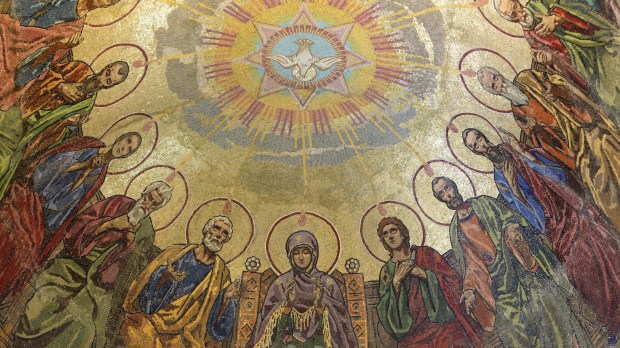Of all the ancient Mediterranean symbols the Christian church adopted, the dove was probably the most frequently repeated in liturgical art, ritual vessels, lamps, catacomb walls, tombs, sarcophagi, and buildings, from the very early days of Christianity. But why?
Almost all Christian artists chose the dove to represent the Holy Spirit. Of course, there are clear, straightforward biblical reasons for this, found both in the Old and New Testaments, from Genesis to the Gospels. For instance, Talmudic commentaries on the book of Genesis, as well as some of the Dead Sea scrolls, affirm the Spirit of God hovered over the face of the waters (Gen 1:2) “like a dove which hovers over her young without touching [them],” introducing the dove motif at the very beginning of all biblical narrative. Also, virtually everyone is familiar with the part played by the dove in the story of the Flood: a dove brought Noah an olive branch, announcing the abating of the waters and of God’s anger. This narrative led both Jews and Christians to an understanding of the olive branch as a symbol of peace, and of the dove as its herald. In Christian representations of the Noahic cycle, the ark naturally became the symbol of the Church, Noah that of the Christian soul to whom the Christ-Dove brings peace, and the flood a prefiguration of Christian baptism.
Also, one finds doves in the Psalms (Ps. 74) and in Solomon’s Song of Songs. In the latter, the groom compares his bride to a dove (“O, my dove in the clefts of the rock […] let me see your face, let me hear your voice”). Ancient peoples in the Mediterranean already knew doves are monogamous, and form strong bonds as lifelong pairs. In fact, some ancient texts would even claim (inaccurately) that doves put to death any of their kind who commit adultery. The dove, then, would be not only the symbol of peace, but also of purity and fidelity. Some other ancient Mediterranean sources (Cretan, mainly) insisted the dove had no gall bladder, and consequently knew no malice. The souls of the departed in the pre-Hellenic Greek archipelago would sometimes be pictured as doves with human heads.
However, it is in the evangelical accounts of the baptism of Jesus where we find the definitive Christian association of the symbol of the dove and the Holy Spirit. All four Gospels refer to the baptism of Jesus by John at the Jordan River, but whereas Matthew, Mark, and John would say the Spirit descended from Heaven “like a dove” (a formulation very much open to interpretation), Luke would rather say the Spirit “descended on him in bodily form, like a dove” (Lk. 3:22), seemingly taking the “dove metaphor” one step further. Once accepted as the evangelical emblem of the Holy Spirit, the dove would then be placed above Mary’s head, also descending from Heaven, in the moment of the Annunciation in art (and sometimes would even allegorically take the place of the Virgin herself, because of the connections that the Song of Songs makes between the dove and the bride chosen over all other women), as well as in some representations of Pentecost.

